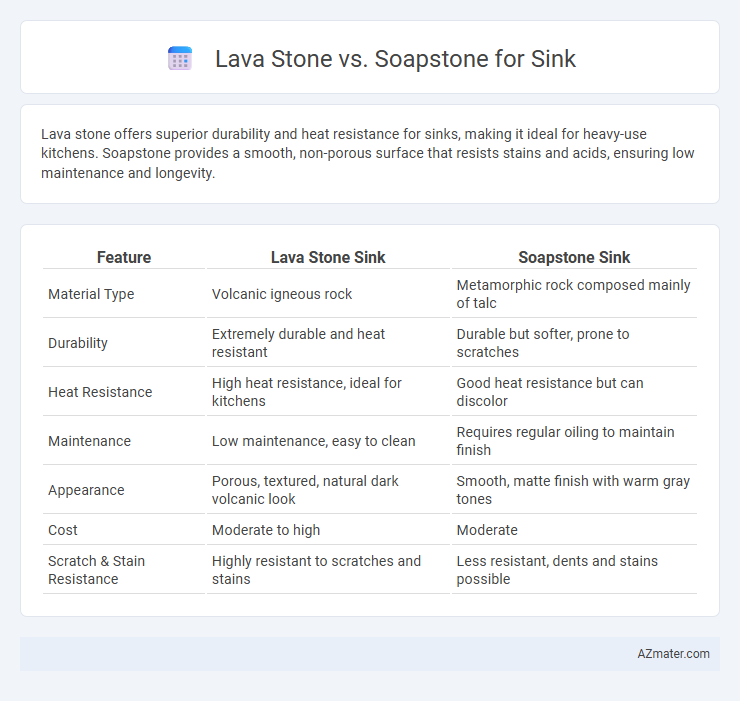Lava stone offers superior durability and heat resistance for sinks, making it ideal for heavy-use kitchens. Soapstone provides a smooth, non-porous surface that resists stains and acids, ensuring low maintenance and longevity.
Table of Comparison
| Feature | Lava Stone Sink | Soapstone Sink |
|---|---|---|
| Material Type | Volcanic igneous rock | Metamorphic rock composed mainly of talc |
| Durability | Extremely durable and heat resistant | Durable but softer, prone to scratches |
| Heat Resistance | High heat resistance, ideal for kitchens | Good heat resistance but can discolor |
| Maintenance | Low maintenance, easy to clean | Requires regular oiling to maintain finish |
| Appearance | Porous, textured, natural dark volcanic look | Smooth, matte finish with warm gray tones |
| Cost | Moderate to high | Moderate |
| Scratch & Stain Resistance | Highly resistant to scratches and stains | Less resistant, dents and stains possible |
Introduction to Lava Stone and Soapstone Sinks
Lava stone sinks, crafted from volcanic basalt, are renowned for their durability, heat resistance, and natural porous texture that provides a unique aesthetic and enhanced grip. Soapstone sinks, made from dense metamorphic rock rich in talc, offer exceptional resistance to stains, bacteria, and heat, with a smooth, matte finish that darkens and gains character over time. Both materials present eco-friendly options, combining timeless beauty with functional performance ideal for modern and rustic kitchen designs.
Formation and Characteristics of Lava Stone
Lava stone forms from rapidly cooled molten lava, resulting in a dense, durable, and porous material ideal for sinks requiring heat and impact resistance. Its natural vesicular texture provides a unique aesthetic with high thermal stability and low water absorption, making it less prone to stains compared to soapstone. Lava stone's volcanic origin contributes to its hardness and longevity, distinguishing it from soapstone, which is softer, non-porous, and primarily composed of talc and magnesium silicate.
Formation and Characteristics of Soapstone
Soapstone is a metamorphic rock primarily composed of talc, formed through the alteration of ultramafic rocks under low-grade regional metamorphism, resulting in a smooth, dense, and heat-resistant material ideal for sinks. Its softness allows for easy carving and shaping, while its non-porous nature resists stains and bacterial growth, making it highly durable and hygienic in kitchen use. Unlike lava stone, which is igneous and volcanic in origin with a porous texture, soapstone's consistent density and resistance to acids contribute to its longevity and aesthetic appeal in sink applications.
Aesthetic Appeal: Color, Texture, and Style
Lava stone sinks showcase a deep, rich black color with a slightly porous texture that offers a bold, modern aesthetic perfect for contemporary kitchens. Soapstone sinks feature a smooth, matte surface with soft gray or greenish hues that develop a natural patina over time, enhancing their rustic and classic charm. Both materials complement distinct interior styles: lava stone suits minimalist designs, while soapstone fits traditional or vintage-inspired spaces.
Durability and Longevity Comparison
Lava stone and soapstone sinks offer distinct durability features, with lava stone known for its exceptional hardness and resistance to scratches and heat, making it highly durable for everyday use. Soapstone, while softer and more prone to dents or scratches, excels in longevity due to its natural ability to develop a protective patina over time that enhances its resistance to stains and chemical damage. Both materials provide long-lasting performance, but lava stone is often favored for high-impact environments, whereas soapstone requires periodic maintenance to preserve its durability.
Heat and Stain Resistance
Lava stone sinks exhibit superior heat resistance due to their volcanic origin and dense mineral composition, allowing them to withstand high temperatures without damage. Soapstone sinks also offer excellent heat resistance but are slightly more susceptible to thermal shock compared to lava stone. In terms of stain resistance, lava stone's non-porous surface prevents absorption of liquids, making it highly resistant to stains, whereas soapstone requires periodic sealing to maintain its stain-resistant properties.
Maintenance and Cleaning Requirements
Lava stone sinks require minimal maintenance due to their natural durability and resistance to heat, stains, and scratches, typically needing only mild soap and water for cleaning. Soapstone sinks demand regular oiling to maintain their dark, smooth finish and prevent drying or fading, with gentle cleaning using non-abrasive cleaners to avoid surface damage. Both materials resist bacterial growth, but soapstone's softer nature necessitates more frequent care to preserve its appearance compared to the tougher, more resilient lava stone.
Environmental Impact and Sustainability
Lava stone sinks are highly sustainable due to their natural volcanic origin, minimal processing requirements, and excellent durability, reducing the need for frequent replacement. Soapstone sinks, derived from metamorphic rock, have low environmental impact because of their long lifespan, non-toxic properties, and ability to be repaired rather than replaced. Both materials offer eco-friendly options, but lava stone slightly outperforms soapstone in terms of renewability and energy consumption during extraction and fabrication.
Cost Differences and Installation
Lava stone sinks generally cost more due to their durability and unique volcanic origin, whereas soapstone sinks are more affordable and offer a softer texture that's easier to shape. Installation of lava stone sinks requires professional expertise because of their weight and fragility, leading to higher labor costs compared to the relatively simpler installation process for soapstone sinks. Both materials demand sealed surfaces, but soapstone's non-porous nature often reduces the need for frequent sealing, influencing long-term maintenance expenses.
Which Sink Material Is Best for You?
Lava stone sinks offer exceptional durability and heat resistance, making them ideal for busy kitchens requiring robust materials that withstand high temperatures and heavy usage. Soapstone sinks provide a naturally smooth, non-porous surface resistant to stains and bacteria, appealing to those prioritizing hygiene and easy maintenance. Choosing between lava stone and soapstone depends on whether you value superior toughness and heat tolerance or prefer a softer, stain-resistant sink with a timeless appearance.

Infographic: Lava stone vs Soapstone for Sink
 azmater.com
azmater.com